Proposal for a Better Big Ten Schedule

Can you name all the Michigan players in this photo from the last Purdue-Michigan game in Ann Arbor? [photo: a much younger Eric Upchurch]
Since going to 14 teams the Big Ten schedule has been a mess. Some teams rarely face each other, other teams face each other twice a season. The divisions are historically and presently uneven. The last two years in a row this resulted in a Big Ten “champion” that had a demonstrably worse season than at least two other Big Ten teams. Congrats Penn State and Michigan State, but I think we can do better. In fact I have an idea how.
I’ll get into the details below but the idea isn’t for everyone to have to memorize the details. The simplest description is every year you play three locked-in rivalry games, three games of your choosing, and three games against schools near you in the standings. Your biggest rivalry is played at the end of the season, and its result (half) carries over to next season.
On FiveThirtyEight’s Solution: Nate Silver’s proposal and mine share a few concepts: locked in rivalries early in the year, a mini-playoff at the end of the year, and eradicating divisions (which is essential to any good schedule reform). But it has two big flaws I tried to avoid:
1) It puts The Game in September, which: no, or in Week 7, which again: no, and then you’re seeding with less information.
2) Teams at the top will rarely face those at the bottom. I don’t like that because it cuts down on variety and could easily lead to things like long droughts between Michigan-Purdue tilts which are one of the things we’re trying to fix. Also it’s not good for the long term health of the conference since it would redistribute more losses from the bottom of the conference to the middle and middle-high. In effect it would result in fewer and lower ranked teams at the top, and fewer bowl-eligible teams from the conference. A few more competitive games is good, but 538’s proposal takes that to an extreme to the detriment of other important considerations.
Goals:
- Maintain the annual rivalries and maximize their importance, keeping the big rival games at the end of the season.
- Play 9 conference games.
- Split up rivalry games so every team has a compelling schedule every year to sell to season ticket holders.
- Produce a fair and least disputable conference champion by playing all or most of the relevant games during the season.
- Play as many competitive games between similarly ranked teams as possible.
- No rematches!
- See a variety of opponents over a 10-year period.
- Encourage Power 5 opponents in non-conference scheduling.
- Be relatively simple.
The system I came up with hit all of these benchmarks to varying degrees (#9 being measured in Kelvin). #5 conflicts with #7 so I left it up to the schools themselves to prioritize between them. As for #9 it’s actually complicated, but can have the appearance of simplicity.
The schedule has four components:
- Three locked-in games versus your annual rivals.
- Three games where the top teams draft their opponents.
- Three games where you play like competition, and the top four teams all play each other.
- A “Big Ten Showcase” invitational during conf championship week to play the best three games that weren’t played.
DIVISIONS
This is the easy part. The teams are all separated into four pods of three or four with rivals they ought to be playing every year.
| Grp | Big Two, Little Bro | East Coast Cable Subscribers | Intercollegiate Conference of Maladroit Representatives | Corn Corn Corn Corn Cheese Corn Corn Corn |
|---|---|---|---|---|
| A | Michigan | Rutgers | Illinois | Wisconsin |
| B | Ohio State | Maryland | Northwestern | Minnesota |
| C | Michigan State | Penn State | Indiana | Iowa |
| D | x | x | Purdue | Nebraska |
The division names are not important but the order is—if you want a clue as to why, look at the A-B and C-D matchups. Teams in your pod are the two or three teams you play every year. There are two ways to handle the three-team pods and I haven’t decided which I like better—either works about the same:
- Option 1: Lock in rivals. Each team gets an annual rival from the opposite division, e.g. Michigan-Maryland is played the week of OSU-MSU, PSU-OSU always comes when Michigan plays State, and Rutgers-Michigan State is played annually on the last week of the season for bragging rights and the Situation Trophy.
- Option 2: Rotate every 2 years. So after two seasons of the above, Michigan plays Rutgers on week 1, Ohio State plays Maryland, and the Land Grant Trophy becomes the end-of-year rivalry for MSU. Then after two years it becomes M-PSU, OSU-Rutgers, MSU-Maryland.
I sorta prefer Option 1 but Option 2 seems more feasible.
[HIT THE JUMP to see how I worked it all out]
HOME & AWAY
This looks a little complicated but the gist of it is that every year your school’s season ticket package will include either two rivalry games at home, or one rival and five conference games.
| Week | Group A | Group B | Group C | Group D |
|---|---|---|---|---|
| 1 | Home vs C | Home vs D | Road vs A | Road vs B |
| 2 | Road vs C | Road vs D | Home vs A | Home vs B |
| 3-5 | 1/3 home | 2/3 home | 1/3 home | 2/3 home |
| 6-8 | 1/3 home | 2/3 home | 1/3 home | 2/3 home |
| 9 | Home vs B | Road vs A | Home vs D | Road vs C |
These flip every year. Fans will be able to buy season tickets knowing when and where the rivalry games will be played, and how many home games they’ll have in the meat of the schedule.
Ideally they’d know the dates of all of their home and road games beforehand, so a Michigan fan living in New York can plan a buddies weekend on, say, Week 6 knowing there will at least be a competitive game.
START THE CONFERENCE SEASON WITH 2 RIVALRY GAMES
These games are pre-scheduled and played every year on the opening two weekends for the conference. They never change, so you can always count on Michigan-Michigan State being at X venue on Y week. The first week Team A hosts Team D, and Team B hosts Team C. The two team A’s who don’t have a game play each other. The second week Team A plays at C and Team B plays at D. So here’s how that looks for our example 2017 season:
| Week 1 | Week 2 |
|---|---|
| Mich. St. @ Ohio St. | Michigan @ Mich St. |
| PSU @ Rutgers | Rutgers @ Maryland |
| Nebraska @ Wisconsin | Wisconsin @ Iowa |
| Iowa @ Minnesota | Minnesota @ Nebraska |
| Purdue @ Illinois | Illinois @ Indiana |
| Indiana @ Northwestern | Northwestern @ Purdue |
| Maryland @ Michigan | Ohio State @ Penn State |
So far simple enough. It’s still September and we’ve gotten some annual rivalries out of the way. We also have every team with 2 games played: a home and a road.
When to play this is up in the air. There’s an argument to make these games start in mid-to-late September so teams can get themselves geared up for conference season, as it’s always been. On the other hand since we’re determining the next part of the schedule later I think it’s best to play these games starting Week 2 of the regular season.
DRAFT OPPONENTS FOR WEEKS 3-5
If Michigan-Minnesota want more Jug dates they can prioritize that. [Patrick Barron]
To make the schedule for the next three weeks, we let the highest-ranked teams choose their own opponents. First we need to seed them, which I do thusly:
- +2 points for every conference win this year
- -2 points for every conference loss this year
- +1 point for winning last year’s big rivalry game.*
- +1 point per victory over power 5 team this year
- Tiebreakers: 1) head to head, 2) current AP rank 3) wins over P5 schools, 4) wins versus FBS, 5) points scored/points allowed vs FBS**
----------------------------------
* [Yes, the result of The Game last year counts for this year’s conference record. I’ll get into why I did this later on.]
** [Since we’re into unranked teams by this point running up the score is not so much a concern.]
----------------------------------
The first two teams pick their three opponents. The next two teams pick two opponents. Then 5 and 6 pick one opponent each, and the conference fills in the rest. When choosing opponents there are rules:
- No rematches. Can’t take a team they already played or a final week rival.
- Can’t choose a team ranked directly behind them (so the #1 team can’t take the #2 team at home and take away the #2 team’s right to choose their 3 opponents).
- Must respect Home/Away splits (so for example if a Group B team already has a road game scheduled you can’t schedule them for a road slot).
The opponent draft will be held, ideally, on Sunday or Monday of the week prior to the week the next round of games will be played, so fans will have most of two weeks to make their travel plans.
Why an opponent draft? Mostly because this way there’s some flexibility. Rather than leaving it up to the conference to juggle everyone’s needs (rivalries, homecoming, distance, draw, time since we last played, better opponents, easier ones, etc.) the schools themselves get some measure of control over their conference scheduling.
Giving the leading schools their pick of opponents gives more flexibility and lets fans have some input on who they play, for example Ohio State fans could push their athletic department to schedule Illinois if they haven’t played them very often in order to get the Illibuck Trophy back. Michigan might choose to schedule a game at Northwestern or Rutgers because they can knock out a road game and count on their fans to create a home atmosphere at those venues.
Let’s go back to our pretend 2017. Yellow means a team won their Week 1 or 2 game with said opponent, blue means they lost. Purple are the drafted matchups.
Undefeated Penn State was ranked higher than Wisconsin, and chose the easiest route with their two home games and one road, visiting Purdue and hosting Minnesota and Michigan State (they couldn’t take Rutgers since they already played). Wisconsin did the same, going to Purdue and Rutgers and hosting Illinois.
Michigan, held back by last year’s loss in The Game, is seeded 3rd, so we got two spots to fill, choosing to face arch-rival Illinois at home and, under immense pressure from Greg Dooley, taking Minnesota for their other road game. We wanted Northwestern but couldn’t choose them because they’re ranked directly below—Northwestern wanted no part of us, riding their easy early season schedule to an easier middle of the schedule with tilts at Minnesota and a visit from Rutgers. Ohio State opted for the Illibuck game in Week 4. Iowa chose Purdue. The conference filled in the rest.
Those games are announced, and then played, and everyone is re-seeded.
At this point we have a general idea of who’s in contention for the Big Ten crown and who isn’t. It’s time to punch your weight.
Note: I think this idea is cool and adds to the interest of a season, but it also can be done away with and replaced with pre-scheduled rotating games against the 10 teams you’re not locked into playing every year.
SEED OPPONENTS FOR WEEKS 6-8
This time there’s no draft—it’s seeded by the conference with the best teams playing each other and then working on down. First, any games between the top four league leaders that haven’t been played (or won’t be later) are locked in like so: Week 6 is 1v4 and 2v3, Week 7 it’s 1v3 and 2v4, and in Week 8 it’s 1v2 and 3v4.
The remaining empty spots are each filled, top-down, with the hardest opponent still available, with the higher ranked team getting the home game if they have one available.
For our example, I showed these mini-playoff games in salmon:
We now have a complete Big Ten schedule.
END THE SEASON VERSUS YOUR BIG RIVAL
The Game. Paul Bunyan’s Axe. The Oaken Bucket. The Situation Trophy. Whatever Illinois and Northwestern play for now. Something they came up with for Iowa-Nebraska. Penn State versus how stupid “Unrivaled” sounds. The BIG games! They’re all held the weekend before Thanksgiving.
You know, when the students are still in town, assholes.
And they are big, not just because they’ll determine your final seeding this year, but because you’re going to have to live with the result all next year as a +1 or –1 modifier on your conference record.
Let’s sim this out now and see where we stand. Remember scoring is +/- for last year’s rivalry game, +2 per win, –2 per loss, and +1 per non-conference Power 5 win.
So the winner of the Game takes the top spot in the conference. No need for conference championship games.
NO WE NEED MORE MONEY PLAY A CHAMPIONSHIP GAME
Interdivisional championship games are dumb. What the end of the season should be used for is to play the best games that weren’t played all year. If I had my druthers, I’d say get the Pac 12 to play the same kind of schedule then play our champions against each other in the Rose Bowl.
But for plausibility’s sake let’s say the Big Ten is going alone. I’d suggest then that we have a three-game showcase where we play the best three games of the year that weren’t played.
PREFERRED OPTION: Play in the higher seed’s home stadium.
REALISTIC OPTION: Rent out some NFL stadiums. If we’re going this route, let the top teams, in order, choose from the available venues, be they Ford Field, Indianapolis, Minnesota, Green Bay, whatever. Most plausible system would be to put two games in Indianapolis or Detroit, and one in the other, with the first two “hosts” having their pick.
Back to our simulated season to see who didn’t play whom:
The best team Michigan didn’t play is #6 Nebraska. Ohio State missed #5 Northwestern. Wisconsin skipped #4 Maryland. Let’s play those the week after Thanksgiving, again with 2 points going to victors and –2 to losers. Those left out also get –2 points. Trust me, it’s fair. You could also award 4 points to the victors and nothing to losers—it’s literally the same difference.
Huskers have to visit Ford Field, Ohio State makes Northwestern travel to Indianapolis, and Maryland upsets Wisconsin in Indy. End of Big Ten season.
HOW DID WE DO?
Let’s check in on the goals:
1. Maintain the annual rivalries and maximize their importance, keeping the big rival games at the end of the season.
✔ The rivalry games all get played in predictable weeks, with the biggest rivalries haunting you all next year as effectively half a game in the conference standings.
2. Play 9 conference games.
✔ Plus we snuck in a 10th for 6/14 teams.
3. Split up rivalry games so every team has a compelling schedule every year to sell to season ticket holders.
✔ The divisions were organized to put your biggest rival in Week 9, your next rival in Week 2, and that team you happen to share a region with in Week 1, so your top two rivals are never both home or away any given year.
4. Produce a fair and least disputable conference champion by playing all or most of the relevant games during the season, and play as many competitive games between similarly ranked teams as possible.
✔ The mix of the middling in Weeks 3-5 and the mini-playoff at the end made sure that the closer you got to the Big Ten crown, the harder your schedule was likely to get, producing a champion who’d already faced any other contender. Adding half-wins for last year’s rivalry game and power 5 opponents added information to produce far fewer ties. The best team that either Michigan or Ohio State didn’t play was #8 Iowa.
The winner of this was Northwestern, who got to skip Wisconsin and Maryland while playing two easy rivals to start the seeding, but that ultimately earned the Wildcats a visit from Michigan, and trips to Penn State and Ohio State.
5. No rematches!
✔ We made a rule.
6. See a variety of opponents over a 10-year period.
✔-minus. The pick-your-poison round provides an opportunity to schedule teams and head to venues that fans haven’t seen recently, if their schools so desire. Over time the top teams will miss the middle tier unless they choose to schedule them. That might be a good thing—is that 8th win for Iowa or 9th loss for Purdue more important to those respective teams?
7. Encourage Power 5 opponents in non-conference scheduling.
✔ Scheduling more P5 competition is incentivized by making those victories part of the conference formula. That doesn’t differentiate between Alabama or Vanderbilt but you don’t really want Big Ten teams playing Alabama outside of the playoff. There are no points to lose if you don’t win except in AP poll tiebreakers.
8. Be relatively simple.
Fail. This is a long article. But I think most people could behind “9 games: 3 vs rivals, 3 vs your choice, and 3 vs someone your own size, and your biggest rivalry counts for half a game next year.”
The draft portion should create a little bit more engagement. Also the teams are still going to be ordered by conference record—the difference between 8-2 and 7-3 is four points, so to make up that difference a team would need to have beaten its big rival last year and have three Power 5 wins in the non-conference portion AND have a head-to-head win or be ranked higher. At that point it makes sense.
OTHER PROBLEMS INHERENT IN THE SYSTEM HELP HELP MICHIGAN STATE IS BEING REPRESSED
I told you, we’re an anarcho-syndicalist commune.
There are some issues.
Michigan State has to start 0-2 every year. By locking in rivalries early in the year you’ll end up seeing a lot of the same teams drafting. If Northwestern beat Illinois the previous year and can get past Indiana and Purdue, they’ll usually be in a position to choose their opponents. By contrast Michigan State would have to defeat Ohio State and Michigan to ever pick whom they play. Hopefully it’s some consolation that a game with Rutgers is worth extra. Also catching their 5-star-recruitin’, high-turnover rivals earlier in the season should be an advantage a good MSU team would be in position to use. This isn’t a problem.
Fans don’t know who/when they’re playing. While the rivalry games are known far out in advance, imagine trying to plan a homecoming game in there. I tried having specific weeks be home/away ahead of time but it severely cuts down on the matchups you can offer/create in weeks 3-8. But we can have soft home dates (subject to change), where matchups get shuffled around after they’re made in order to fit each team’s home/road schedule.
Last year’s Game affecting this year? On one hand college football is about continuity and rivals, so making a rivalry game hang around your neck for another year is right in line with how things should be. But I get that wiping the slate clean every summer is part of the game. Ultimately this was the way to preserve the higher importance of end-of-the-year rivalries versus the rest of the schedule, but I acknowledge there’s something wrong with that.
Something else I didn’t think of? You tell me.
February 9th, 2017 at 12:26 PM ^
February 9th, 2017 at 1:01 PM ^
Nah... just get rid of the stupid super-conferences. Bring back the Big East and redistribute all of them back to ten teams. You play all nine other conf teams and no more conf championship games.
It's the only 'fair' way to do it. Everyone plays the exact same conf schedule.
It'll never happen, but it'd be nice to see.
February 9th, 2017 at 3:11 PM ^
avatar is perfect here too.
February 9th, 2017 at 12:24 PM ^
February 9th, 2017 at 12:25 PM ^
February 9th, 2017 at 12:25 PM ^
1) Go to 20 teams
2) Have one division with the following: Michigan, MSU, OSU, Wisconsin, IU, Illinois, Purdue, Minnesota, Iowa, and NW. I don't care who is in the other division.
3) Play a nine game schedule in your division.
4) Have a championship game with the other division if you want. Or don't.
5) Pretend that PSU and Rutgers never happened. (I do feel a bit bad for Nebraska. Their fans seemed like nice people.)
February 9th, 2017 at 12:32 PM ^
Conference Mergers and increasing size has become an abomination.
Get the original Big Ten as one division and the Pac Ten as the other division. RoseBowl is the conference championship. The TV money would be great.
February 9th, 2017 at 1:42 PM ^
Yes. I'm always sad that we missed this opportunity. Already has a great tradition, similar academic profiles, similar athletic profiles, etc. etc. From a revenue perspective a Big 10/Pac10 combined network would be worth a ton of cash for the new combined league too.
Might be hard for some sports (e.g., Hockey), but for Basketball, Football, Swimming, Track, etc it would be great. For football it would be great to schedule one rotating regular season cross-conference game too. Not too much travel, but would keep things interesting.
Oh well.
February 9th, 2017 at 12:28 PM ^



For Magnus only - no one else look:
February 9th, 2017 at 12:30 PM ^
Funny, on the gif with the woman in the bikiini it took me a few minutes to notice that she was making gestures with her hands and arms.
February 9th, 2017 at 12:40 PM ^
She has hands and arms?
February 9th, 2017 at 1:07 PM ^
gesture was aimed at me and meant " i want to bear your children"
February 9th, 2017 at 1:33 PM ^
For some reason I was focused on the center of the picture.
February 9th, 2017 at 3:25 PM ^
She's a mega youtube star. I've only watched that bikini video, i have no idea why her clothes wearing videos have millions of views.
February 9th, 2017 at 4:05 PM ^
She's actually hilarious
February 10th, 2017 at 6:52 PM ^
That's right, that's her name, i find her incredibly, annoyingly unfunny though.
February 9th, 2017 at 12:26 PM ^
This will never happen.
February 9th, 2017 at 12:27 PM ^
February 9th, 2017 at 1:47 PM ^
Only 3 games (rivalry games) would be scheduled ahead of time.
February 9th, 2017 at 3:12 PM ^
February 9th, 2017 at 4:32 PM ^
ya know like school and travel...these things need to be planned lol
February 9th, 2017 at 12:28 PM ^
I think it's obvious that we need to add more teams to the Big 10. /S
February 9th, 2017 at 2:20 PM ^
I would argue the BIG needs to add two more teams and have it be four divisions of four teams. You play 3 division games every year, and rotate two teams from each other division for a total of 6 out of division games and a grand total of nine games. At the end of the season, you have a four team playoff where the four division winners play for the big ten championship.
February 9th, 2017 at 3:22 PM ^
Is this even workable? Under this plan you would have to stop at 8 conference games and then play two rounds of playoffs (adding the one week). You can't do it after the season so one game has to be played when the current regular season is played.
February 9th, 2017 at 3:25 PM ^
My guess is this will be the first of many "proposed schedules" that we will see between now and the first game in Dallas!
February 9th, 2017 at 5:02 PM ^
Just what college football needs.
February 9th, 2017 at 12:29 PM ^
Just one question regarding Rule 8, Seth: relative to what?
February 9th, 2017 at 12:32 PM ^
What is the purpose of these fix the schedule hypotheticals? They are always logistically impossible, so what's the point? Teams sometimes have trouble making schedules years in advance, but somehow they're going to get it together in a couple of weeks?
February 9th, 2017 at 12:36 PM ^
Random content for Feb 9?
February 9th, 2017 at 12:36 PM ^
I track the secondary ticket market closely during the season; most travel decisions appear to be made starting 2-3 weeks out. More important is having foreknowledge of home games, since fans who live out of town like to plan a week to come. In that case they'll have to content themselves with "it'll be a good game."
February 9th, 2017 at 1:34 PM ^
Ok, but what about logistics of team travel? How far out are team travel arrangements made? Can P5 football programs pick up and arrange game day travel with out a few days lead time? E.g., draft Monday, travel Friday morning?
February 9th, 2017 at 1:50 PM ^
He said the draft would happen the week before the week of the game. So you'd draft Monday, then have the game 12 days later. You would have a non-conference game in week 3 I guess.
February 9th, 2017 at 12:35 PM ^
That I see is that the flexibile schedule underestimates how many people travel to home games from 2+ hours away and/or by plane. You have to book these trips out in advance and people (myself included) often plan their fall around the 1 or 2 trips they get to make home for Michigan games. That doesn't work if you have no idea what the schedule looks like from weeks 3-8.
February 9th, 2017 at 12:43 PM ^
I love the idea behind this and I sincerely hope there is some smart, young intern at the B10 offices who is trying to figure out how to pitch this up the food chain. But you have to remember that old conservative rich guys run things and they tend to be resistant to change and prefer gradual things. So here are some ideas for you to think about:
-
$$$$$ None of the leadership in college athletics or the B10 specifically will do anything unless it makes them money. Show them how to make a ton of money off of this idea and they might listen. The three games at the end are a good start.
-
While your method uses data and attempts to create a balanced schedule, is there a v1.0 of this method that at least makes the scheduling more flexible? Maybe there are two flex weeks per season that are based on records or something?
- I think the simple approach of killing meaningless divisions and setting up 1-3 relevant games on championship weekend is a good start.
February 9th, 2017 at 12:58 PM ^
I liked having 3 games where you pick your poison (the upsets would be incredible because HA HA YOU WANTED THIS!) but yeah the easiest way to simplify this system would be to jettison the pick your poison games and have home-and-homes as you rotate through the season. Then you're only leaving three regular season games (plus the showcase) unscheduled. If you stick a conference-wide bye week in there, that gives fans 2, 3, or 4 weeks to plan their travel.
February 9th, 2017 at 2:21 PM ^
FWIW I think you talked me into at least replacing those "Pick your poison" games with pre-scheduled rotational opponents.
We can do that and keep the rest: 3 games in Weeks 6-8 to play teams on your level so that all of the potential conference champs play each other, and a conference showcase to mop up the last games that weren't played. Conference championship goes to the team that comes out of all of that the strongest.
February 9th, 2017 at 3:06 PM ^
I like the "pick your poison" games too, but I think it's tought to work. The other flaw I noticed is the 1 or 2 home games for the last three weeks before rivalry weekend - what if three teams from pod A are in the top 4 heading into the end of the season?
February 14th, 2017 at 1:54 PM ^
I considered that. There's a way to break it.
The teams in a pod all play each other already so they would never end up playing each other weeks 6-8. So the way this home-away thing becomes a problem is if 4 teams with the same home-road schedule who don't play each other.
Groups:
5 home games: OSU, NWern, PSU, Minn, MSU, Indiana, Nebraska
4 home games: Mich, Illini, MD, Wis, Rutgers, Purdue, Iowa
When scheduling weeks 3-5 the Big Ten just has to make sure it always plays two games within those groups. If we get rid of the pick-your-poison deal the Big Ten could mostly innoculate itself from this scenario by how it rotates those matchups.
- Rotation 1: MSU plays PSU. Mich plays Wisconsin, Rutgers plays Iowa
- Rotation 2: MSU plays NW, PSU plays IN, Mich plays Rutgers
- Rotation 3: MSU plays IN, PSU plays NW, Mich plays Iowa, Rutgers plays Wisconsin
- Rotation 4: MSU plays MN, PSU plays NE, MIch plays Illinois, Rutgers plays Purdue
- Rotation 5: MSU plays NE, PSU plays MN, Miich plays Purdue, Rutgers plays Illinois
That leaves only eight combinations of top four teams that could cause a crisis:
MSU+PSU+NW+MN
MSU+PSU+IN+MN
MSU+PSU+NW+NE
MSU+PSU+IN+NE
Mich+RU+UW+IL
Mich+RU+UW+PU
Mich+RU+IA+IL
MIch+RU+IA+PU
In that case I say give the top overall team an extra home game I guess?
February 9th, 2017 at 12:46 PM ^
Obviously counting 2012 and this year, but how often do we have a "wrong" Conference Champion?
February 9th, 2017 at 1:19 PM ^
2012 was unique because the 1st and 2nd place teams in the leaders were sanctioned. And OSU had already beaten Nenbraska by 25 points so chances are they would have beaten them again in the championship game.
But explain to me how this year we had the "wrong" conference champion?
February 9th, 2017 at 1:44 PM ^
As far as this year goes, I'm just parroting the popular position here. The consensus was that because UM beat Wisconsin and Penn State, that we were more "deserving" of being Big Ten champions
February 9th, 2017 at 3:41 PM ^
Well we didn't win the games that count.
And the "more deserving" argument is stupid. Pitt beat PSU and Clemson. Were they more deserving to be in the playoff?
College football is setup in such a way that everygame counts and if you lose one game you generally need some help in order to be champion. PSU just so happened to get that help when we lost to Iowa and OSU. Michigan wins either of those games and PSU doesn't play in Indy.
February 9th, 2017 at 2:13 PM ^
2016: Ohio State was clearly had the best season in the conference, losing only a fluky rain game at Penn State and not going to the conference championship because their 2-loss opponent lost their other game to a non Big Ten school and the Big Ten is that weird conference who values head-to-head over overall record in determining tiebreakers. Wisconsin won their division but had the 4th best resume in the conference.
2015: Michigan State won a fluky game against OSU in the rain and even flukier game at Michigan (not to mention catching Oregon quarterbackless, and nearly losing to Rutgers and Purdue). They skipped Wisconsin, Northwestern and Iowa (until the B1G CCG). West division champ Iowa went 12-0 and played only one ranked team (#23 Northwestern), skipping Michigan, Ohio State, and Penn State. Ohio State again was held out of the B1G Championship by the head-to-head rules despite being the best team in the conference.
2014: Ohio State played Wisconsin. This was fine.
-------------LEADERS/LEGENDS ERA--------------
2013: Ohio State went undefeated into the B1G CG. In a down year for the conference MSU didn't play a ranked team until they got to the B1G CG, missing Wisconsin and OSU during the regular season.
2012: The top two teams in the Leaders Division were ineligible for the postseason so Legends Division champ Nebraska played 8-5 Wisconsin in a rematch (ick). OSU and PSU also would have been rematches FWIW.
2011: Wisconsin won a down Leaders Division without playing Michigan, setting up a rematch with Michigan State who beat up Michigan and also won a football game against us.
So since we created the divisions only once have we gotten a Big Ten Championship that wasn't a rematch or involved some team that got there by dumb luck and circumstance rather than competitive play. That's a systemic problem (nothing against the teams who went). And it's easy to solve by simply not creating arbitrary divisions or placing too much emphasis on any one aspect.
The thing I like about replacing the CG game with showcase games is every year we'll get to see interesting matchups that we didn't see already. The thing I like about having 3 weeks at the end of the season for a mini-playoff is it lets you wait to see which teams have earned pole position and play the crucial games you'll need to determine a champ.
February 9th, 2017 at 2:19 PM ^
Every single conference uses head to head result to break two team ties though...
I didn't realize that non-conference games counted towards the big ten championship.
February 9th, 2017 at 2:35 PM ^
conference championship, MSU did technically beat both teams that were better than them - on the road no less. So while they weren't the best team, they did deserve to be in the title game and there's no argument that balancing the schedule any other way would have prevented that.
2016, yes, PSU didn't play Wisconsin in the regular season and had much easier crossover games which is the primary reason they were able to be in the title game rather than the better teams in the division.
EDIT: Sorry, yes, the West div champs Iowa did not deserve to be in the title game and Wisco didn't deserve to last year. Don't mind me, I'll just be whistling over here in the corner.
February 9th, 2017 at 9:07 PM ^
February 9th, 2017 at 1:13 PM ^
2015, but that wasn't the schedule's fault.
2014 and 2015 both featured terrible West division champions that were obviously outclassed by multiple East division teams.
Considering the championship game has only existed for 6 years, the rate of satisfying results has been pretty low.
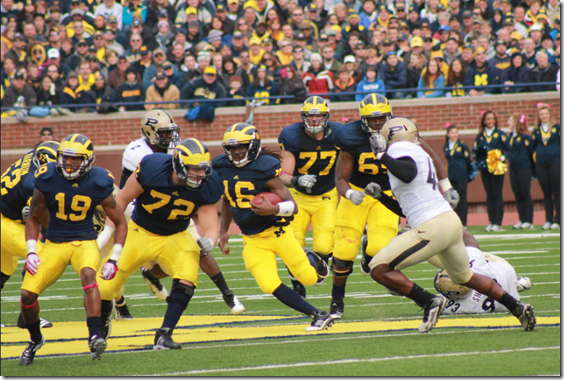
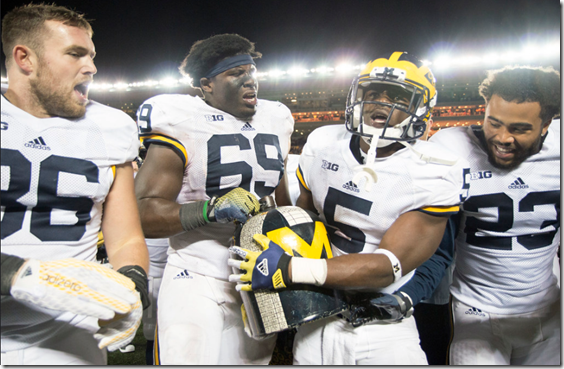

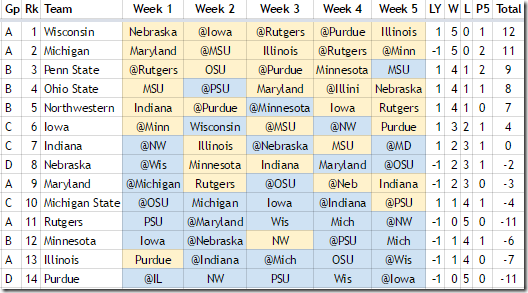
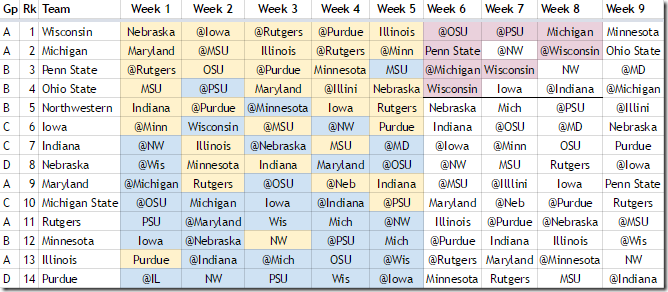
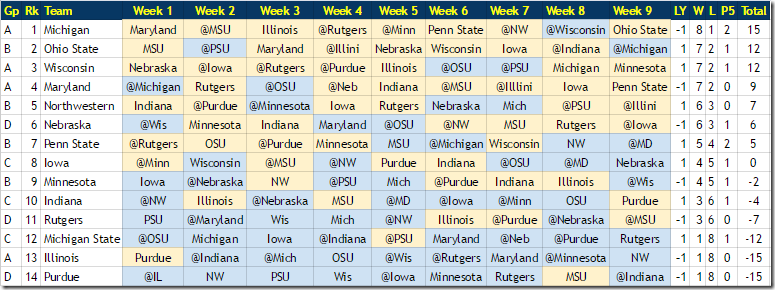
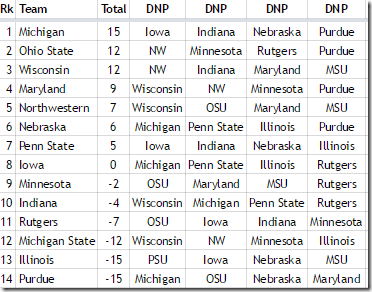
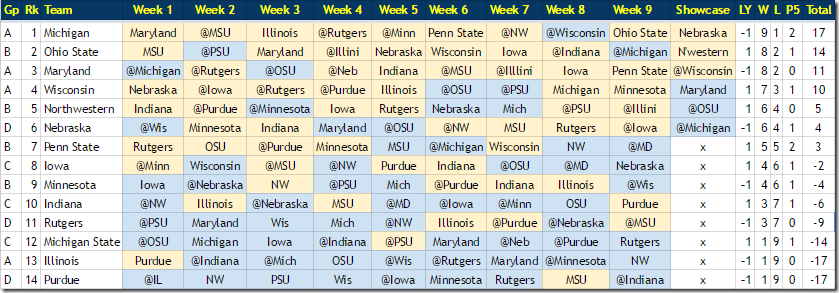





Comments